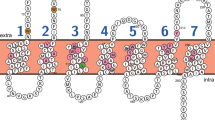Abstract
Autofluorescent chromatophores were detected in 17 out of 71 zooxanthellate coral species studied. Chromatophores are localized either in the oral gastrodermic (endoderm) or oral epidermis (ectoderm). The pigment granules within the chromatophores (0.5–1.0 μm in diameter) show a brilliant light-blue/turquoise autofluorescence (emission between 430 and 500 nm) after excitation with light of 365–410 nm. All species where the autofluorescent gastrodermal chromatophores form a compact layer, embedding the zooxanthellae, belong to the family Agariciidae. In contrast, some species of the Faviidae (2), Pectiniidae (1) and Mussidae (1) were found to have distinct, autofluorescent chromatophores in the oral epidermis. Autofluorescent pigments of the host may enhance photosynthesis of the symbionts as in Leptoseris fragilis. Short wavelength irradiance, less suitable for photosynthesis, is transformed by host pigments into longer wavelengths which are photosynthetically more effective. Thus, host species possessing autofluorescent chromatophores might have selective advantage over non-fluorescent species, and have the potential to survive in light-limited habitats. Furthermore, the daily period of photosynthesis is extended, thus increasing the energy supply and enhancing the deposition of skeletal carbonate. The absence or presence of chromatophores may have value in taxonomy and could putatively be of plalaeontological and palaeoecological interest.
Similar content being viewed by others
References
Cloney RA, Florey E (1968) Ultrastructure of cephalopod chromatophore organs. Z Zellforsch 89: 250–280
Drollet JH, Glaziou P, Martin PMV (1993) Study of the mucus from the solitary coral Fungia fungites (L. 175) (Scleractinia, Fungiidae) in relation with the photobiological UV adaptation. in Proceedings of the 7th International Coral Reef Symposium, Guam, USA (in press)
Dunlap WC, Chalker BE (1986) Identification and quantification of near-UV absorbing compounds (S-320) in a hermatypic scleractinian. Coral Reef 5: 155–159
Fricke HW, Schuhmacher H (1983) The depth limits of the Red Sea stony corals: an ecophysiological problem (a deep diving survey by submersible) Mar Ecol Prog Ser 4: 163–194
Fricke HW, Vareschi E, Schlichter D (1987) Photoecology of the coral Leptoseris fragilis in the Red Sea twilight zone (an experimental study by submersible) Oecologia 73: 371–381
Goodwin TW (1968) Pigments of coelenterata. In: Florkin M, Scheer BT (ed) Chemical zoology. Academic Press, New York, pp 149–155
Halldal P (1968) Photosynthetic capacities and photosynthetic action spectra of endozoic algae of the massive coral Favia. Biol Bull Mar Biol Lab Woods Hole 134: 411–424
Jerlov NG (1970) Light. In: Kinne O (ed) Marine ecology. Wiley, pp 95–103
Kaiser P, Schlichter D, Fricke HW (1993) Influence of light on algal symbionts of the deep water coral Leptoseris fragilis Mar Biol 117: 45–52
Kawaguti S (1944) On the physiology of reef corals. VI. Study on the pigments. Contr Palao Trop Biol Stn 2: 616–673
Kawaguti S (1969) Effect of the green fluorescent pigment on the productivity of the reef corals. Micronesica 5:313
Levanon-Spanier I, Padan E, Reiss Z (1979) Primary production in a desert-enclosed-sea-the Gulf of Elat (Aqaba), Red Sea. Deep-Sea Res 26: 673–685
Logan A, Halcrow K, Tomascik K (1990) UV excitation-fluorescence in polyp tissue of certain scleractinian corals from Barbados and Bermunda. Bull Mar Sci 46: 807–813
Patterson MP (1992) A chemical engineering view of cnidarian symbiosis. Am Zool 32: 566–582
Pilkington JB (1969) The organization of skeletal tissues in the spines of Echinus esculentus. J Mar Biol Assoc UK 49: 857–877
Scelfo G (1985) The effect of visible and ultraviolet solar radiation on a UV-absorbing compound and chlorophyll a in a hawaiian zoanthid. Proc Int Coral Reef Congr 6: 107–112
Scheer G, Pillai CSG (1983) Report on the Stony Corals from the Red Sea. Zoologica Stuttg 45: 1–198
Schlichter D (1990) Coral host improves photosynthesis of endosymbiotic algae. Naturwissenschaften 77: 447–450
Schlichter D, Fricke HW (1991) Mechanisms of amplification of photosynthetically active radiation in the symbiotic deep-water coral Leptoseris fragilis. Hydrobiologia 216/217: 389–394
Schlichter D, Weber W, Fricke HW (1985) A chromatophore system in the hermatypic, deep water coral Leptoseris fragilis (Anthozoa: Hexacorallia). Mar Biol 89: 143–147
Schlichter D, Fricke HW, Weber W (1986) Light harvesting by wavelength transformation in a smybiotic coral of the Red Sea twilight zone. Mar. Biol 91: 403–407
Schlichter D, Fricke HW, Weber W (1988) Evidence for PAR enhancement by reflection, scattering and fluorescence in the symbiotic deep water coral Leptoseris fragilis (PAR = photosynthetically active radiation). Endocyt Cell Res 5: 83–94
Scott BD, Jitts HR (1977) PHotosynthesis of phytoplankton and zooxanthellae on a coral reef. Mar Biol 41: 307–315
Sheppard CRC, Sheppard ALS (1991) Corals and coral communities of Arabia. Fauna Saudi Arabia 12: 1–170
Shibata K (1969) Pigments and a UV-absorbing substance in corals and a blue-green alga living in the Great Barrier Reef. Plant Cell Physiol 10: 325–335
Smith RC, Tyler JE (1976) Transmission of solar radiation into natural waters. Photochem Photobiol Rev 1: 117–155
Spurr RA (1969) A low-viscosity epoxy embedding medium for electron microscopy. J Ultrastruct Res 26: 31–43
Veron JEN, Pichon M, Wijsman-Best M (1977) Scleractinia of Eastern Australia. II. Families Faviidae, Trachyphyllidae. Aust Inst Mar Sci Monogr Ser 3: 233 pp
Wellington GM, Gleason DF (1993) Monitoring of ultraviolet light fluxes along a depth gradient in San Salvador Island, Bahamas. Proceedings of the 7th International Coral Reef Symposium, Guam, USA (in press)
Wethey DS, Porter JW (1976) Habitat-related patterns of productivity of the foliaceous reef coral, Pavona praetorta DANA. In: Mackie GO (ed) Coelenterate ecology and behavior. Plenum, New York, pp 59–66
Author information
Authors and Affiliations
Rights and permissions
About this article
Cite this article
Schlichter, D., Meier, U. & Fricke, H.W. Improvement of photosynthesis in zooxanthellate corals by autofluorescent chromatophores. Oecologia 99, 124–131 (1994). https://doi.org/10.1007/BF00317092
Received:
Accepted:
Issue Date:
DOI: https://doi.org/10.1007/BF00317092




